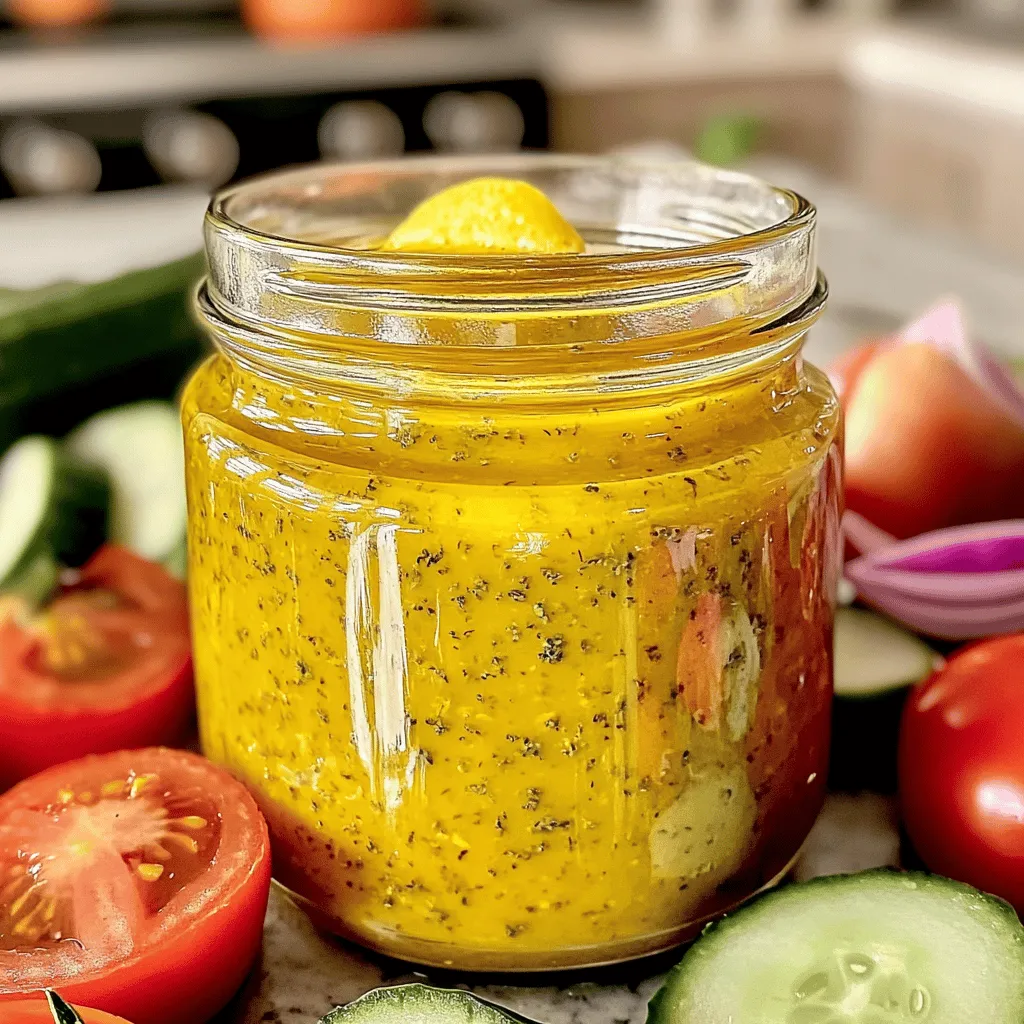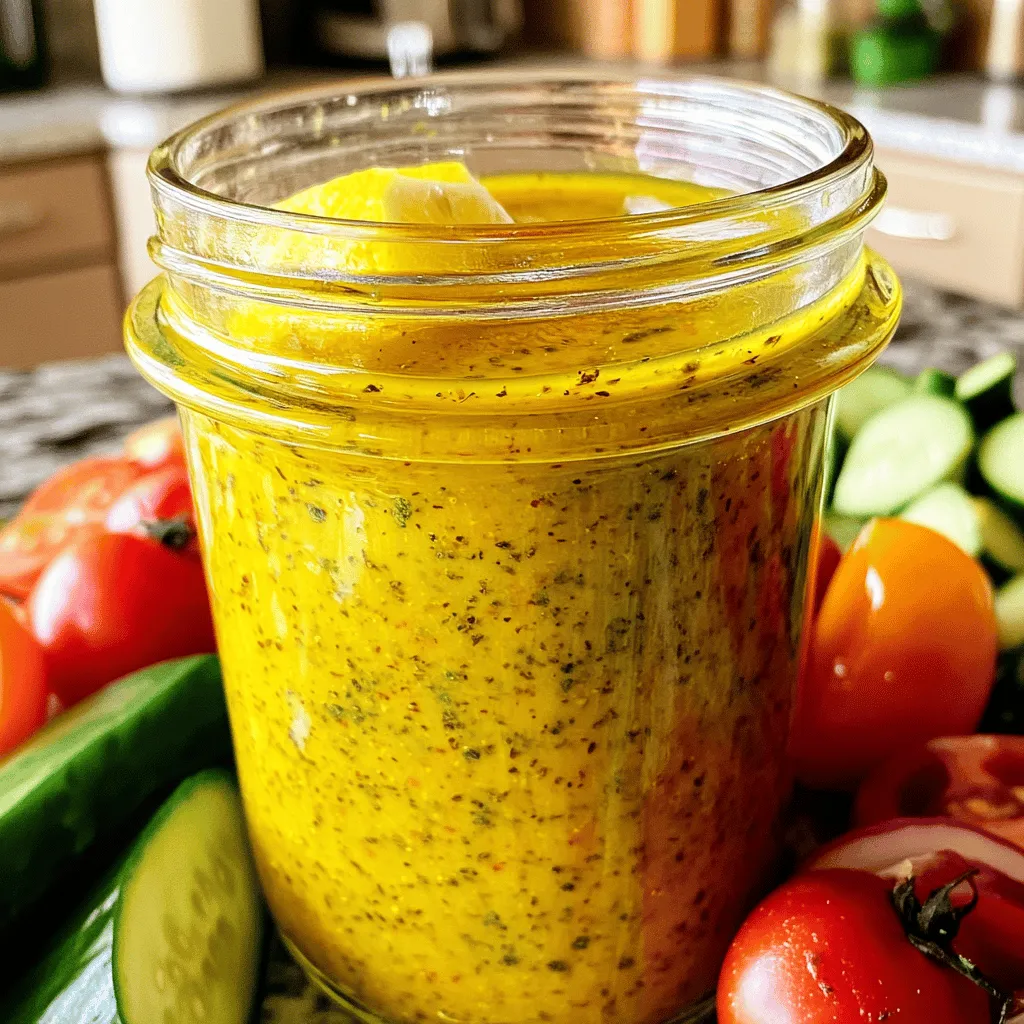Making your own Greek salad dressing is easier than you think. With simple ingredients, you can create a fresh, flavorful mix that lifts any salad. This dressing not only enhances the taste but also adds a vibrant twist to your meals. In this article, I’ll share my favorite recipe, tips, and variations to help you make the perfect Greek dressing. Let’s dive into the delicious world of Greek flavors!
Ingredients
Required Ingredients for Greek Salad Dressing
To make a great Greek salad dressing, you need a few key ingredients:
– 1/2 cup extra virgin olive oil
– 1/4 cup red wine vinegar
– 1 tablespoon freshly squeezed lemon juice
– 1 teaspoon dried oregano
– 1 teaspoon Dijon mustard
– 1 clove garlic, finely minced
– 1/2 teaspoon sea salt
– 1/4 teaspoon freshly cracked black pepper
These ingredients create a fresh and tangy flavor that is the heart of this dressing. The olive oil adds richness, while the vinegar gives it a nice bite.
Optional Ingredients and Flavor Enhancements
You can make this dressing even better with some optional add-ins:
– 1 teaspoon honey (for natural sweetness)
– Fresh herbs like parsley or dill (for added freshness)
– A pinch of red pepper flakes (for some heat)
Adding honey gives a lovely balance to the acidity. Fresh herbs brighten the dressing and make it feel vibrant.
Ingredient Substitutions
Don’t have an ingredient? No problem! Here are some swaps:
– Use white wine vinegar instead of red wine vinegar.
– Swap Dijon mustard with yellow mustard if that’s what you have.
– If you run out of olive oil, try avocado oil for a different twist.
These substitutions help you keep the flavor while using what you have on hand. Feel free to get creative and adapt the dressing to your taste!
For the complete details on making this Greek salad dressing, check out the Full Recipe.
Step-by-Step Instructions
Detailed Steps to Make Greek Salad Dressing
To start, gather all your ingredients in a medium mixing bowl. You will need:
– 1/2 cup extra virgin olive oil
– 1/4 cup red wine vinegar
– 1 tablespoon freshly squeezed lemon juice
– 1 teaspoon dried oregano
– 1 teaspoon Dijon mustard
– 1 clove garlic, finely minced
– 1/2 teaspoon sea salt
– 1/4 teaspoon freshly cracked black pepper
– 1 teaspoon honey (optional)
First, whisk together the red wine vinegar, lemon juice, Dijon mustard, minced garlic, dried oregano, sea salt, black pepper, and honey if using. Whisk until smooth and well mixed. Next, drizzle in the olive oil slowly while whisking. This step helps the dressing to blend and become creamy.
Emulsifying Techniques for Creamy Consistency
Emulsifying means mixing two ingredients that don’t usually combine, like oil and vinegar. To do this well, whisk the mixture vigorously as you add the olive oil. The goal is a smooth dressing that coats your salad nicely. If you find it too thin, add a bit more mustard. This will help thicken it.
Tasting and Adjusting Seasoning
Taste your dressing! This step is key. Adjust the flavor by adding more sea salt, black pepper, or honey based on what you like. Remember, a pinch can make a big difference. Once it’s perfect, pour the dressing into a clean jar. Seal it tightly and chill it in the fridge for at least 30 minutes. This time lets the flavors blend beautifully. Before serving, shake the jar to mix any settled bits. Drizzle it over your fresh Greek salad or use it for grilled veggies. Enjoy the burst of flavor!
For the complete recipe, check out the Full Recipe section.
Tips & Tricks
Storage Tips for Homemade Greek Dressing
To keep your dressing fresh, store it in a clean jar. Seal it tightly and place it in the fridge. Homemade Greek dressing lasts about one week. Always check for any off smells before use. If it separates, just shake it well before serving.
Best Practices for Serving Greek Salad Dressing
Always serve your dressing cold for the best flavor. A good rule is to use about three tablespoons per salad. Drizzle it over fresh greens and veggies just before serving. This keeps the salad crisp and flavorful. If you want a more intense taste, let the salad sit for a few minutes after dressing.
How to Incorporate into Various Dishes
You can use this dressing in many ways. It works well as a marinade for grilled chicken or fish. It also adds zing to roasted vegetables. Try drizzling it over pasta salads or grain bowls, too. The possibilities are endless with this fresh and flavorful dressing. For the complete recipe, check the Full Recipe section above.

Variations
Popular Variations of Greek Salad Dressing
You can change up your Greek salad dressing in many ways. Try adding herbs like basil or parsley for a fresh twist. Some people love a creamier version. To achieve this, mix in a bit of Greek yogurt. This gives it a nice tang and thick texture.
Alternative Flavor Profiles to Try
Want to explore new flavors? Add a splash of balsamic vinegar for sweetness. You can also use lime juice instead of lemon juice. This gives your dressing a unique zest. For a spicier kick, mix in red pepper flakes or a bit of sriracha. Each option adds something special to the dressing.
Ingredient Swaps for Dietary Preferences
Need to adjust for dietary needs? Swap regular honey with agave syrup for a vegan option. If you’re watching your salt, use low-sodium soy sauce instead of sea salt. You can also use avocado oil if you’re looking for a different oil flavor. These swaps make the dressing fit your lifestyle while keeping it delicious.
Remember, you can find the full recipe at the end of the article.
Storage Info
How to Store Homemade Dressing
Storing your Greek salad dressing is easy. First, pour the dressing into a clean jar or a sealable container. Make sure to seal it tightly. Place it in the fridge to keep it fresh. Always label your jar so you know what’s inside.
Shelf Life and Signs of Spoilage
Homemade Greek salad dressing lasts about one week in the fridge. If you notice any changes, it’s time to toss it. Look for changes in color, smell, or texture. If it smells bad or has separated too much, it’s best to throw it away.
Freezing Homemade Greek Salad Dressing
You can freeze Greek salad dressing for later use. Pour the dressing into ice cube trays. Once frozen, transfer the cubes to a freezer bag. It will last about three months in the freezer. When you want to use it, just thaw a few cubes in the fridge overnight.
FAQs
What is the best way to make Greek Salad Dressing?
To make Greek salad dressing, you need to mix a few key ingredients. Start with red wine vinegar and fresh lemon juice. Add Dijon mustard and minced garlic for depth. Then, include dried oregano, sea salt, and black pepper. Whisk these together in a bowl. Slowly pour in extra virgin olive oil while whisking. This helps create a creamy texture. Taste the dressing and adjust the seasoning if needed. For detailed steps, check the Full Recipe.
Can I make Greek Salad Dressing in advance?
Yes, you can make Greek salad dressing in advance. It’s a great idea! Making it a day ahead lets the flavors blend well. Store it in a sealed jar in the fridge. Before using, shake it well to mix everything again. This way, your dressing is ready when you need it.
Is Greek Salad Dressing vegan-friendly?
Yes, Greek salad dressing is vegan-friendly. All the main ingredients, like olive oil and vinegar, come from plants. You can skip the honey if you want to keep it strictly vegan. The dressing will still taste great without it.
What store-bought Greek Salad Dressing options are recommended?
When looking for store-bought Greek salad dressing, look for options with simple ingredients. Brands that use real olive oil and natural vinegar are best. Some popular choices include Annie’s and Ken’s Steakhouse. Always check the label to avoid unwanted additives.
Full Recipe
Complete Recipe Overview with Ingredients and Instructions
To make Greek salad dressing, you need simple, fresh ingredients. Here’s what you’ll need:
– 1/2 cup extra virgin olive oil
– 1/4 cup red wine vinegar
– 1 tablespoon freshly squeezed lemon juice
– 1 teaspoon dried oregano
– 1 teaspoon Dijon mustard
– 1 clove garlic, finely minced
– 1/2 teaspoon sea salt
– 1/4 teaspoon freshly cracked black pepper
– 1 teaspoon honey (optional)
Follow these easy steps:
1. Gather all your ingredients in a medium bowl.
2. Whisk together the red wine vinegar, lemon juice, Dijon mustard, garlic, oregano, salt, black pepper, and honey if you want some sweetness.
3. Whisk until everything is well mixed and smooth.
4. Slowly add the olive oil while whisking. This helps make the dressing creamy.
5. Taste it! Adjust the salt, pepper, or honey to fit your taste.
6. Pour the dressing into a clean jar. Seal it and chill it in the fridge for 30 minutes.
7. Before using, shake it well. Drizzle over your Greek salad or use it to marinate grilled veggies or chicken.
This recipe takes about 10 minutes to prep and gives you about 1 cup of dressing.
Nutritional Information per Serving
Each serving of this Greek salad dressing is both tasty and healthy. Here’s a quick look at the nutrition:
– Calories: 85 kcal
– Total Fat: 9.5 g
– Saturated Fat: 1.3 g
– Sodium: 150 mg
– Carbohydrates: 1 g
– Sugars: 0.5 g
This dressing is low in calories and packed with healthy fats from the olive oil.
Serving Suggestions and Presentation Ideas
Serving Greek salad dressing is easy and fun! Here are some tips:
– Use a decorative glass jar.
– Add a sprig of fresh oregano or rosemary for a nice touch.
– Label the jar with a cute tag to show off your creation.
– Drizzle it over a vibrant Greek salad, or use it as a dip for fresh veggies.
This dressing not only tastes great but also looks beautiful on your table!
Making Greek salad dressing is easy and fun. We explored the key ingredients, from essentials to tasty add-ons. I shared detailed steps for blending a creamy mix and how to tweak flavors. You learned storage tips and how to use the dressing in meals. Many variations exist to suit your taste too.
In the end, this dressing elevates your salads and dishes. Enjoy making it your own!

